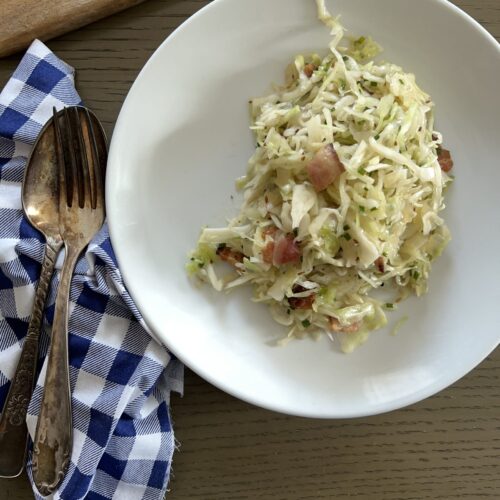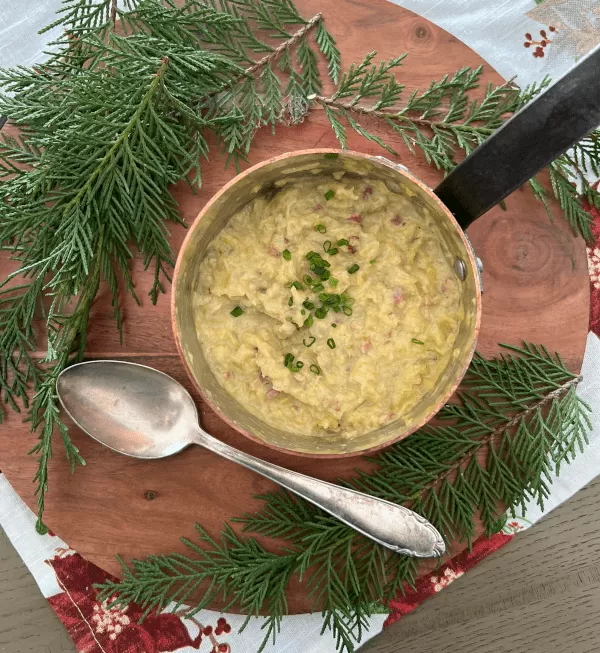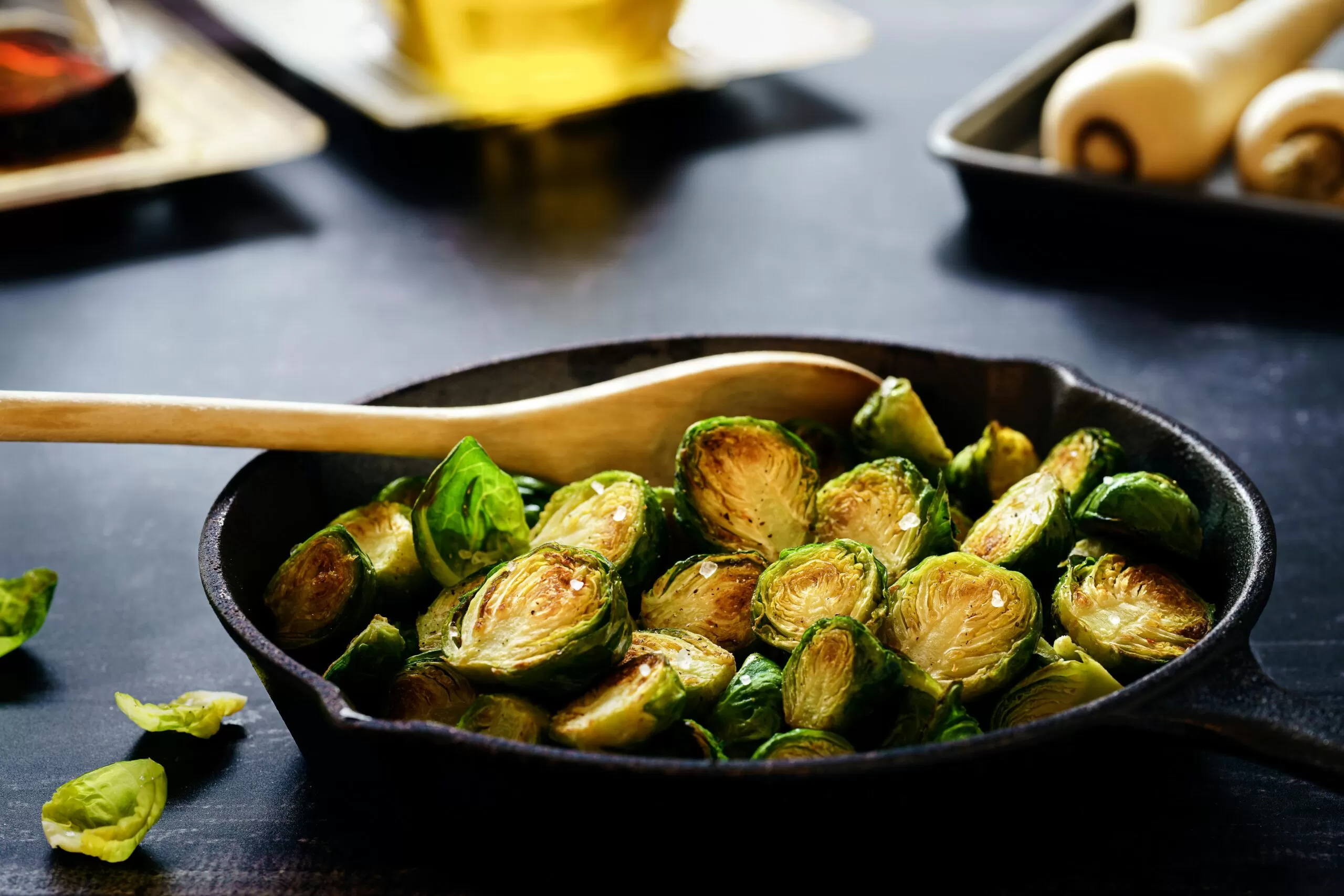Cabbage salad is almost like a cole slaw without the mayo. Growing up in Pennsylvania, surrounded by a rich German-American community, I was no stranger to the many varieties of cabbage dishes that are a staple in our cuisine. But there’s one dish that has always stood out to me as a refreshing counterpoint to the robust, fermented flavors of sauerkraut: Bavarian Krautsalat mit Speck. This dish is light, tangy, and has a subtle smokiness from the bacon that makes it irresistible. Unlike sauerkraut, which is fermented over time, Krautsalat is a fresh cabbage salad, offering a crisp, clean flavor that’s perfect for balancing out heavier dishes.

The Difference Between Krautsalat and Sauerkraut
To understand the beauty of Krautsalat, it’s important to first understand how it differs from its more famous cousin, sauerkraut. Sauerkraut is made by fermenting finely shredded cabbage in its own juices, often with added salt and sometimes other seasonings. This process can take anywhere from a few days to several weeks, depending on the desired level of fermentation. The result is a tangy, slightly sour product with a long shelf life.
Krautsalat, on the other hand, is a fresh salad made from raw cabbage. It’s quick to prepare and has a bright, clean flavor profile. The cabbage is usually salted to draw out some of the moisture, which softens the leaves slightly, but it retains its crisp texture. The dressing, often made with vinegar and oil, gives it a refreshing tang, while the addition of bacon adds a hint of smokiness that complements the dish without overpowering it. Unlike sauerkraut, Krautsalat is meant to be enjoyed soon after it’s made, making it a vibrant, fresh option that’s perfect for a side dish or a light meal.
My Journey with Krautsalat
My first memories of Krautsalat are tied to family gatherings and community events at the Reading Liederkranz. It was a dish that always seemed to make an appearance, often served alongside grilled sausages, schnitzels, or roast pork. What I loved most about it was its versatility—Krautsalat could hold its own as a side dish but also provided a refreshing contrast to richer, heavier meats. As I began to explore my own culinary path, I found myself returning to this simple yet satisfying salad, experimenting with the flavors and refining the technique.
One of the things that makes Krautsalat so appealing to me, especially as a chef, is its adaptability. While the classic version includes bacon, it can easily be made vegan by omitting the bacon or replacing it with smoked tofu or a similar plant-based alternative. It’s also naturally gluten-free, making it accessible to a wide range of diners. Over the years, I’ve come to appreciate these qualities more and more, particularly as I’ve worked to create dishes that are inclusive and can be enjoyed by everyone at the table.
Ingredients for Bavarian Krautsalat mit Speck
Here’s the recipe I’ve developed over time, staying true to the traditional flavors while incorporating a few touches that I’ve found enhance the dish:
- 500 g white cabbage
- 1 tbsp salt (for salting the cabbage)
- 100 g smoked bacon (can be omitted for a vegan version)
- 1 small onion or half of a medium one (finely diced)
- 2 tsp sugar
- 1/4 cup white wine vinegar
- 1/4 cup vegetable broth
- 1/2 tbsp caraway seeds (crushed)
- 2 tbsp canola or safflower oil
- 1/2 bunch fresh chives (finely chopped)
- Salt and pepper to taste

Step-by-Step Instructions
- Prepare the Cabbage: Start by finely shredding the white cabbage. You want thin, even strips for the best texture. A mandolin is best here. They’re inexpensive and extremely versatile in the kitchen. Just be careful! A brand new one is extremely sharp. The knife is literally a large razor blade!
- Place the shredded cabbage in a large bowl, sprinkle with 1 tablespoon of salt, and toss to combine. Let the cabbage sit for about 20-30 minutes. This process draws out some of the moisture, softens the cabbage, and seasons it lightly.
- Cook the Bacon: While the cabbage is resting, cook the smoked bacon in a skillet over medium heat until it’s crispy and golden brown. Once cooked, remove the bacon from the pan and set it aside, leaving the rendered fat in the skillet. The bacon fat will be used to sauté the onions and add depth of flavor to the dressing.
- Sauté the Onions: Add the finely diced onion to the skillet with the bacon fat. Sauté the onions over medium heat until they become translucent and soft, about 5 minutes. The onions should take on a bit of the bacon’s smokiness, which will infuse the entire dish with a subtle, savory flavor. After the onions have softened, add the sugar and stir to dissolve.
- Assemble the Salad: Rinse the salted cabbage under cold water to remove any excess salt, then drain it well and squeeze out any remaining water. Transfer the cabbage to a large mixing bowl. Pour the dressing over the cabbage, add the crushed caraway seeds, and season with salt and pepper to taste. Stir everything together until the cabbage is evenly coated with the dressing.
- Finish with Chives and Bacon: Finally, fold in the finely chopped fresh chives and the crispy bacon pieces (if using). The chives add a burst of fresh, herbal flavor that brightens the dish, while the bacon brings a satisfying crunch and smokiness.
- Serve and Enjoy: Bavarian Krautsalat mit Speck is best served fresh, but it can also be made a few hours ahead and refrigerated until ready to serve. If you’re making it ahead of time, give it a quick toss before serving to redistribute the dressing.
A Light and Refreshing Alternative
What I love most about Bavarian Krautsalat mit Speck is how it stands apart from the more familiar sauerkraut. While sauerkraut has its place, particularly alongside hearty dishes like sausages or pork knuckles, Krautsalat offers something different. It’s lighter, fresher, and has a crisp texture that’s incredibly satisfying. The tanginess of the vinegar, the subtle warmth of the caraway seeds, and the richness of the bacon all come together to create a dish that’s complex yet wonderfully simple.
This salad is also incredibly versatile. It pairs beautifully with grilled meats, roasted vegetables, or even just a slice of good, crusty bread. And because it’s so easy to adapt, it can fit into a variety of dietary preferences. Want to keep it vegan? Skip the bacon and add a touch of smoked paprika to the dressing for that smoky flavor. Need it gluten-free? You’re already there—just make sure your broth is gluten-free, and you’re good to go.
The Vegan and Gluten-Free Option
One of the things I’ve come to appreciate more and more in my career is the importance of inclusivity in cooking. Food should bring people together, and that means creating dishes that everyone can enjoy, regardless of dietary restrictions. Bavarian Krautsalat mit Speck is a perfect example of a dish that can be easily adapted to meet different needs without sacrificing flavor.
To make this salad vegan, simply omit the bacon. You can add a little extra oil to the dressing or use a small amount of smoked tofu to replicate the bacon’s texture and flavor. The rest of the recipe remains the same, allowing you to enjoy the light, refreshing taste of Krautsalat in a completely plant-based form.
As for gluten-free diners, this dish is naturally free of gluten, as long as you use a gluten-free vegetable broth. It’s a great option for those looking for a side dish that’s both satisfying and safe for gluten-sensitive guests.
Bringing It All Together
Bavarian Krautsalat mit Speck is more than just a side dish—it’s a celebration of the simple, fresh flavors that make German cuisine so special. Whether you’re serving it alongside a traditional Bavarian meal or just enjoying it on its own, this salad is sure to delight your taste buds and bring a bit of Bavaria to your table.
Over the years, I’ve found that it’s the simple dishes like this one that often have the most profound impact. They remind us of our roots, our heritage, and the joy of gathering around the table with family and friends. And in a world that’s always moving so fast, there’s something incredibly comforting about taking the time to prepare and enjoy a dish like Krautsalat—a dish that’s as much about the experience of making it as it is about the pleasure of eating it.
So, the next time you’re looking for a fresh, tangy, and satisfying side dish, I encourage you to try your hand at Bavarian Krautsalat mit Speck. Whether you make it with bacon or go the vegan route, I’m confident you’ll find that this simple cabbage salad has a way of winning over everyone who tries it. And who knows? It might just become a new favorite in your kitchen, as it has in mine.

Krautsalat – Bavarian Cabbage Salad
Ingredients
- 1/2 head white cabbage
- 1/4 cup vinegar apple cider or white wine
- 1/4 cup canola oil
- 1 tbsp sugar
- 2 tsp kosher salt
- pepper freshly ground to taste
- 1 tsp caraway seeds lightly crushed
- 2 tbsp fresh chives, finely chopped
Instructions
- Prepare the Cabbage: Start by finely shredding the white cabbage. You want thin, even strips for the best texture. A mandolin is best here. They’re inexpensive and extremely versatile in the kitchen. Just be careful! A brand new one is extremely sharp. The knife is literally a large razor blade!
- Place the shredded cabbage in a large bowl, sprinkle with 1 tablespoon of salt, and toss to combine. Let the cabbage sit for about 20-30 minutes. This process draws out some of the moisture, softens the cabbage, and seasons it lightly.
- Cook the Bacon: While the cabbage is resting, cook the smoked bacon in a skillet over medium heat until it’s crispy and golden brown. Once cooked, remove the bacon from the pan and set it aside, leaving the rendered fat in the skillet. The bacon fat will be used to sauté the onions and add depth of flavor to the dressing.
- Sauté the Onions: Add the finely diced onion to the skillet with the bacon fat. Sauté the onions over medium heat until they become translucent and soft, about 5 minutes. The onions should take on a bit of the bacon’s smokiness, which will infuse the entire dish with a subtle, savory flavor. The onions don’t need to be brown, a little color is fine. After they are cooked and softened, add the sugar and dissolve in the pan.
- Prepare the Dressing: Once the onions are ready, carefully add the white wine vinegar and vegetable broth to the skillet. Stir to combine, scraping up any bits of bacon or onion stuck to the bottom of the pan. This will deglaze the skillet and bring all those delicious flavors into the dressing. Remove the skillet from the heat and let the mixture cool slightly.
- Assemble the Salad: Rinse the salted cabbage under cold water to remove any excess salt, then drain it well and squeeze out any remaining water. Transfer the cabbage to a large mixing bowl. Pour the dressing over the cabbage, add the crushed caraway seeds, and season with salt and pepper to taste. Stir everything together until the cabbage is evenly coated with the dressing.
- Finish with Chives and Bacon: Finally, fold in the finely chopped fresh chives and the crispy bacon pieces. The chives add a burst of fresh, herbal flavor that brightens the dish, while the bacon brings a satisfying crunch and smokiness.
- Serve and Enjoy: Bavarian Krautsalat mit Speck is best served fresh, but it can also be made a few hours ahead and refrigerated until ready to serve. If you’re making it ahead of time, give it a quick toss before serving to redistribute the dressing.
Notes
FAQ: Bavarian Krautsalat mit Speck
1. Can I make Bavarian Krautsalat mit Speck ahead of time?
- Yes, you can prepare Bavarian Krautsalat mit Speck a few hours ahead of time. In fact, letting it sit for a bit allows the flavors to meld together even more. Just be sure to store it in the refrigerator, and give it a quick toss before serving to redistribute the dressing. It’s best enjoyed within a day of making for optimal freshness and texture.
2. What can I use as a substitute for bacon to make this salad vegan?
- To make this salad vegan, simply omit the bacon. You can add a touch of smoked paprika to the dressing to replicate the smoky flavor of the bacon. Alternatively, you can use smoked tofu or tempeh as a substitute, sautéing it in a bit of oil to achieve a similar texture and flavor.
3. Is Bavarian Krautsalat mit Speck gluten-free?
- Yes, Bavarian Krautsalat mit Speck is naturally gluten-free as long as you use a gluten-free vegetable broth. The rest of the ingredients, such as cabbage, vinegar, and bacon, do not contain gluten, making this dish a great option for those with gluten sensitivities or celiac disease.
4. How long can I store leftovers of Krautsalat mit Speck?
- Leftover Krautsalat mit Speck can be stored in the refrigerator for up to 2 days. However, it’s important to note that the cabbage may become softer over time, and the flavors will continue to develop. For the best texture and taste, it’s recommended to enjoy the salad on the day it’s made or the day after.
5. Can I use red cabbage instead of white cabbage?
- Yes, you can use red cabbage instead of white cabbage if you prefer. The flavor will be slightly different—red cabbage has a slightly sweeter and more robust taste—but it will still make a delicious Krautsalat. Keep in mind that red cabbage will also give the salad a vibrant purple color, which can be a beautiful and visually appealing variation.




